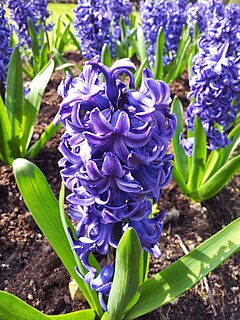
Hyacinthus is a small genus of bulbous, spring-blooming perennials. They are fragrant flowering plants in the family Asparagaceae, subfamily Scilloideae and are commonly called hyacinths. The genus is native to the area of the eastern Mediterranean from the south of Turkey through to the northern part of Israel, although naturalized more widely.

Hyacinthus orientalis, the common hyacinth, garden hyacinth or Dutch hyacinth, is a species of flowering plant in the family Asparagaceae, subfamily Scilloidiae, native to southwestern Asia, southern and central Turkey, northwestern Syria, Lebanon and northern Israel. It was introduced to Europe in the 16th century. It is widely cultivated everywhere in the temperate world for its strongly fragrant flowers which appear exceptionally early in the season, and frequently forced to flower at Christmas time.

Muscari is a genus of perennial bulbous plants native to Eurasia that produce spikes of dense, most commonly blue, urn-shaped flowers resembling bunches of grapes in the spring. The common name for the genus is grape hyacinth, but they should not be confused with hyacinths. A number of species of Muscari are used as ornamental garden plants.
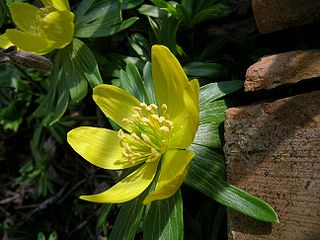
Eranthis hyemalis, the winter aconite, is a species of flowering plant in the buttercup family Ranunculaceae, native to calcareous woodland habitats in France, Italy and the Balkans, and widely naturalized elsewhere in Europe.
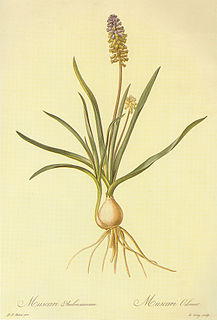
Muscari racemosum is a perennial bulbous flowering plant in the asparagus family Asparagaceae. The members of the genus are commonly known as grape hyacinths. Originally from south-west Turkey where it grows in rocky places, it is sometimes grown as an ornamental plant. It may be found in the horticultural literature under the synonym Muscari muscarimi.

Scilla luciliae is a species of flowering plant in the family Asparagaceae. It is referred to by the common names Bossier's glory-of-the-snow or Lucile's glory-of-the-snow, and is a bulbous perennial from western Turkey that flowers in early spring. After flowering, it goes into dormancy until the next spring. The specific epithet is in honour of Lucile, the wife of the Swiss botanist Pierre Edmond Boissier (1810-1885). It belongs to a group of Scilla species that were formerly put in a separate genus, Chionodoxa, and may now be treated as Scilla sect. Chionodoxa.

Freesia laxa, commonly known as flowering grass, is a small species of cormous flowering plant in the family Iridaceae, from eastern and southern Africa, from Kenya to northeastern South Africa. It is grown in gardens as an ornamental plant.

Muscari botryoides is a bulbous perennial plant of the genus Muscari and one of a number of species and genera known as grape hyacinth. It is sometimes grown as an ornamental plant.

Scilla section Chionodoxa, known as glory-of-the-snow, is a small group of bulbous perennial flowering plants in the family Asparagaceae, subfamily Scilloideae. Formerly treated as the separate genus Chionodoxa, they are now included in Scilla as a section. The section is endemic to the eastern Mediterranean, specifically Crete, Cyprus and Turkey. The blue, white or pink flowers appear early in the year making them valuable garden ornamentals. The common name of the group is based on the habit of flowering in high alpine zones when the snow melts in spring.

Muscari neglectum is a perennial bulbous flowering plant in the asparagus family Asparagaceae. Members of this genus are commonly known as grape hyacinths, and M. neglectum is known as common grape hyacinth or starch grape hyacinth. Muscari are perennial bulbous plants native to Eurasia. They produce spikes of dense, commonly blue, urn-shaped flowers. It is sometimes grown as an ornamental plant, for example, in temperate climates as a spring bulb.

Muscari armeniacum is a species of flowering plant in the squill subfamily Scilloideae of the asparagus family Asparagaceae. It is a bulbous perennial with basal, simple leaves and short flowering stems. It is one of a number of species and genera known as grape hyacinth, in this case Armenian grape hyacinth or garden grape-hyacinth. The flowers are purple, blue, white or pale pink and the plants are usually 15 centimetres (6 in) tall. M. armeniacum blooms in mid-Spring for 3–4 weeks. Some selections are fragrant. Established bulbs leaf in the autumn. M. armeniacum is widespread in the woods and meadows of the Eastern Mediterranean, from Greece and Turkey to the Caucasus, including Armenia which gives it its name.

Ornamental bulbous plants, often called ornamental bulbs or just bulbs in gardening and horticulture, are herbaceous perennials grown for ornamental purposes, which have underground or near ground storage organs. Botanists distinguish between true bulbs, corms, rhizomes, tubers and tuberous roots, any of which may be termed "bulbs" in horticulture. Bulb species usually lose their upper parts during adverse conditions such as summer drought and heat or winter cold. The bulb's storage organs contain moisture and nutrients that are used to survive these adverse conditions in a dormant state. When conditions become favourable the reserves sustain a new growth cycle. In addition, bulbs permit vegetative or asexual multiplication in these species. Ornamental bulbs are used in parks and gardens and as cut flowers.

Scilla forbesii, known as Forbes' glory-of-the-snow, is a bulbous perennial plant from west Turkey flowering in early spring. It is considered synonymous with Scilla siehei, known as Siehe's glory-of-the-snow, by some sources, although others distinguish them. It belongs to a group of Scilla species that were formerly put in a separate genus, Chionodoxa, and may now be treated as Scilla sect. Chionodoxa. After flowering, it goes into dormancy until the next spring. It seeds readily to form colonies.

Scilla sardensis, the lesser glory-of-the-snow, is a bulbous perennial from west Turkey flowering in early spring. After flowering, it goes into dormancy until the next spring. It belongs to a group of Scilla species that were formerly put in a separate genus, Chionodoxa, and may now be treated as Scilla sect. Chionodoxa.

Scilla nana, known as dwarf glory-of-the-snow, is a bulbous perennial from Crete flowering in early spring with flowers in shades of lilac blue. After flowering, it goes into dormancy until the next spring. It belongs to a group of Scilla species that were formerly put in a separate genus, Chionodoxa, and may now be treated as Scilla sect. Chionodoxa. It has not always been recognized as distinct from Scilla cretica.
Scilla lochiae, known as Loch's glory-of-the-snow, is a bulbous perennial from Cyprus flowering in early spring. After flowering, it goes into dormancy until the next spring. It was named after Lady Loch who collected it. It belongs to a group of Scilla species that were formerly put in a separate genus, Chionodoxa, which may now be treated as Scilla sect. Chionodoxa.
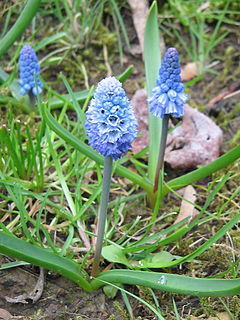
Pseudomuscari is a genus of bulbous perennials in the family Asparagaceae, subfamily Scilloideae. They were formerly included in the genus Muscari. Species of Pseudomuscari have flowers in shades of pale or bright blue, and are small plants with dense flower spikes or racemes. A feature which distinguishes them from Muscari is the bell-shaped flower which is not constricted at the mouth. One species, P. azureum, is popularly grown in gardens as an ornamental Spring-flowering plant.

Muscari aucheri, Aucher-Éloy grape hyacinth, is a species of flowering plant in the squill subfamily Scilloideae of the asparagus family Asparagaceae. It is a perennial bulbous plant, one of a number of species and genera known as grape hyacinths. Originally from Turkey, where it grows in grassy alpine areas, it is sometimes grown as an ornamental plant. The synonym M. tubergenianum may be found in the horticultural literature.
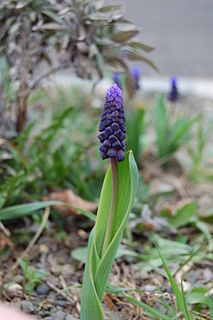
Muscari latifolium, the broad-leaved grape hyacinth, is a species of flowering plant in the family Asparagaceae. The Latin specific epithet latifolium means "broad-leaved".

Pseudomuscari chalusicum, the Chalus grape hyacinth, is a species of flowering plant in the squill subfamily Scilloideae of the asparagus family Asparagaceae, native to Iran. Chalus is a county in northern Iran. Growing to about 15 cm (5.9 in) in height, it is a bulbous perennial with floppy, curved leaves sitting close to the ground, and small clusters of bell-shaped flowers on erect stems, appearing in mid-spring. The flower colour is pale blue at the tip, shading downwards to a darker blue. Unlike some other Muscari species, it does not spread rapidly.



















